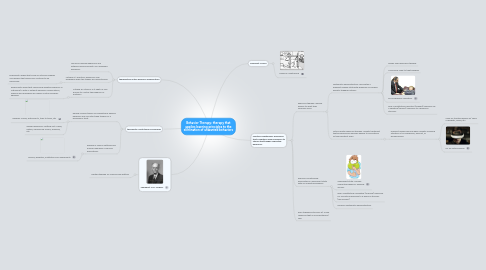
1. Therapist: O.H. Mowrer
1.1. created therapy for chronic bed wetters
2. therapists practice behavior modification
2.1. reinforce desired behaviors and withhold reinforcements for undesired behaviors
2.2. critique #1: practical; behaviors may disappear when the tokens are discontinued
2.2.1. proponents argue that social or intrinsic rewards can replace the tokens and continue to be reinforced
2.3. critique #2: ethical; Is it right for one human to control the behavior of another?
2.3.1. proponents argue that reinforcing adaptive behavior is justified b/c with or without behavior modifications, rewards and punishers will always control people's behavior
3. therapists create token economies
3.1. people receive tokens for exhibiting a desired behavior and can later trade tokens for a privilege or treat
3.1.1. rewards: candy, watching tv, trips to town, etc
3.1.2. desired behaviors: getting out of bed, eating, cleaning up rooms, washing, etc
3.2. applied in various settings and among members of various populations
3.2.1. homes, hospitals, institutions for delinquents
4. counterconditioning: procedure that conditions new responses to stimuli that trigger unwanted behaviors
4.1. exposure therapy: expose people to what they normally avoid
4.1.1. systematic desensitization: associates a pleasant relaxed state with gradually increasing anxiety-triggered stimuli
4.1.1.1. widely used exposure therapy
4.1.1.2. commonly used to treat phobias
4.1.1.3. ex: progressive relaxation
4.1.1.4. goal: substituting a positive (relaxed) response for a negative (fearful) response to a harmless stimulus
4.1.2. virtual reality exposure therapy: anxiety treatment that progressively exposes people to simulations of their greatest fears
4.1.2.1. efficient middle ground when anxiety-arousing situation is too expensive, difficult, or embarrassing
4.1.2.1.1. used for treating people w/ fears of heights, flying, etc
4.1.2.1.2. ex: 3D virtual worlds
4.2. aversive conditioning: associates an unpleasant state with an unwanted behavior
4.2.1. unpleasant state: nausea; unwanted behavior: drinking alcohol
4.2.2. goal: substituting a negative (aversive) response for a positive response to a harmful stimulus (like alcohol)
4.2.3. reverses systematic desensitization
